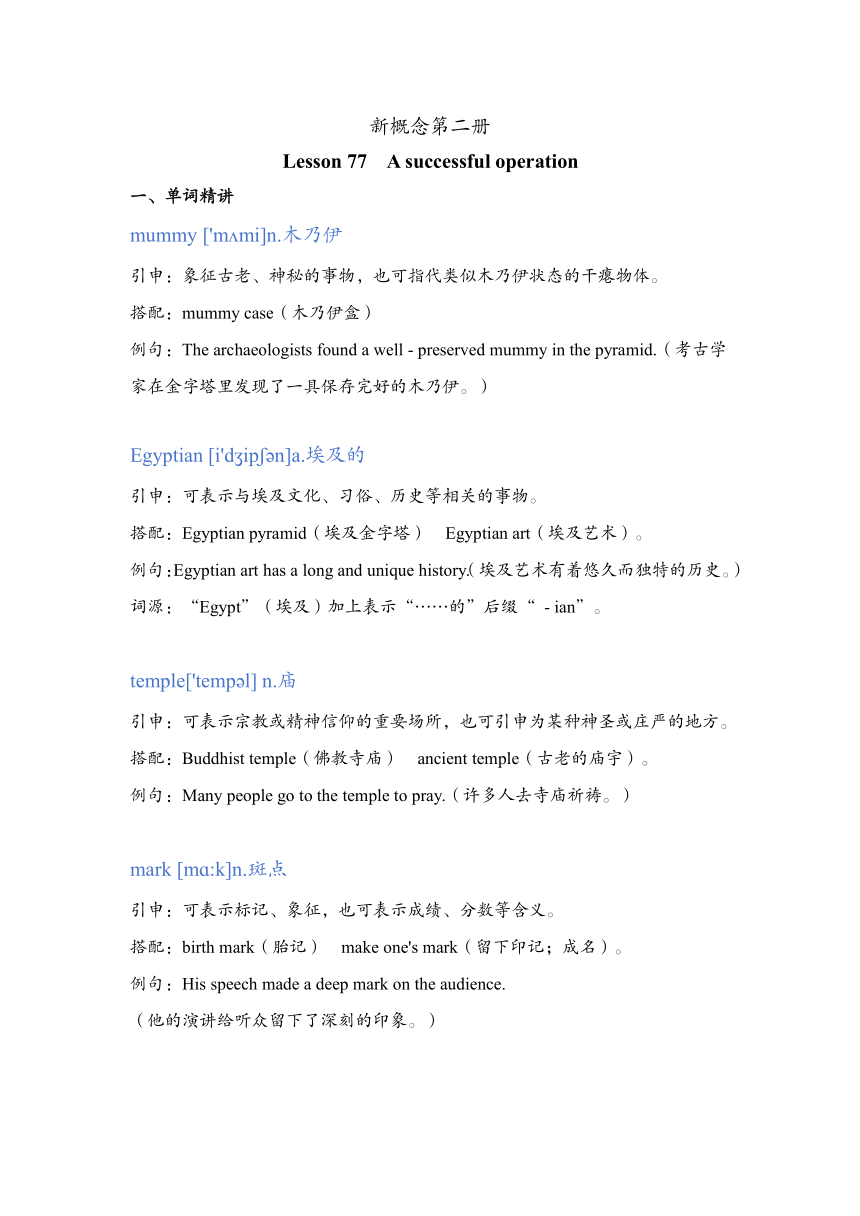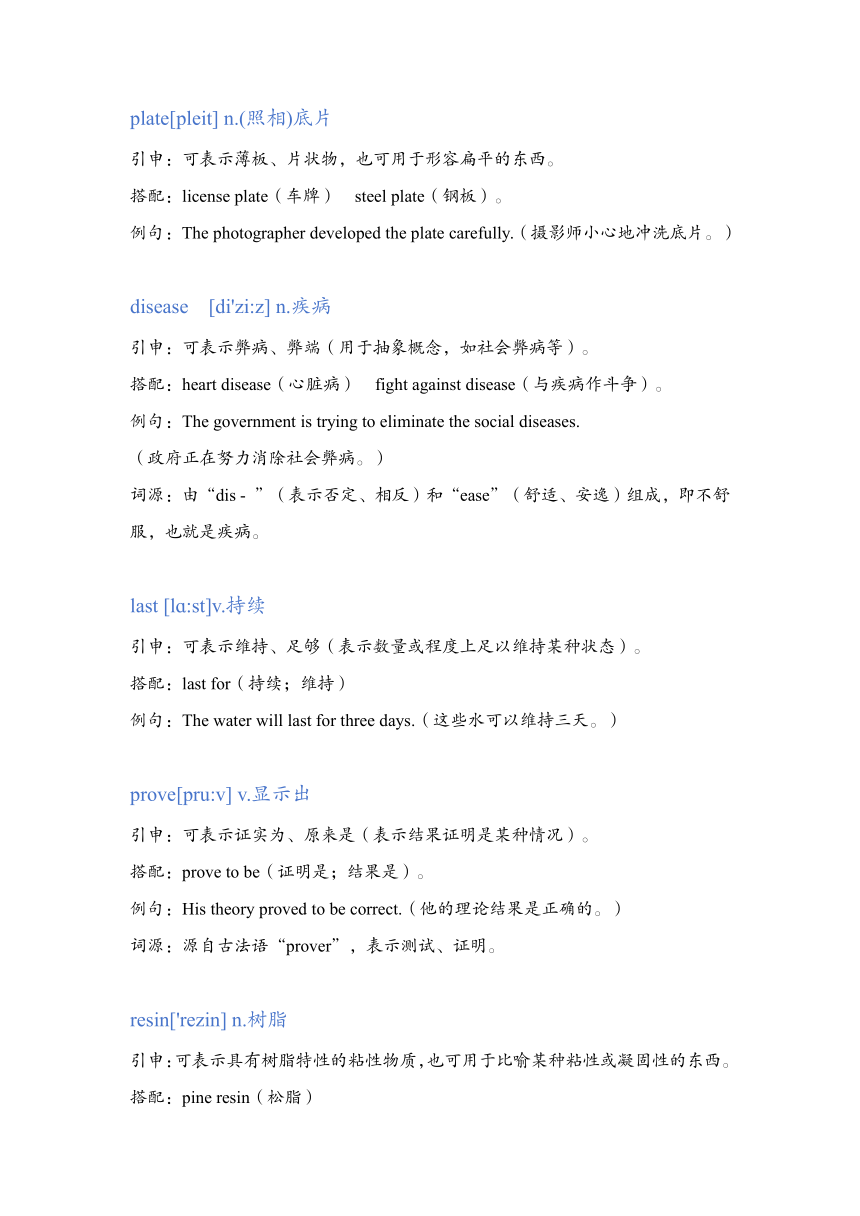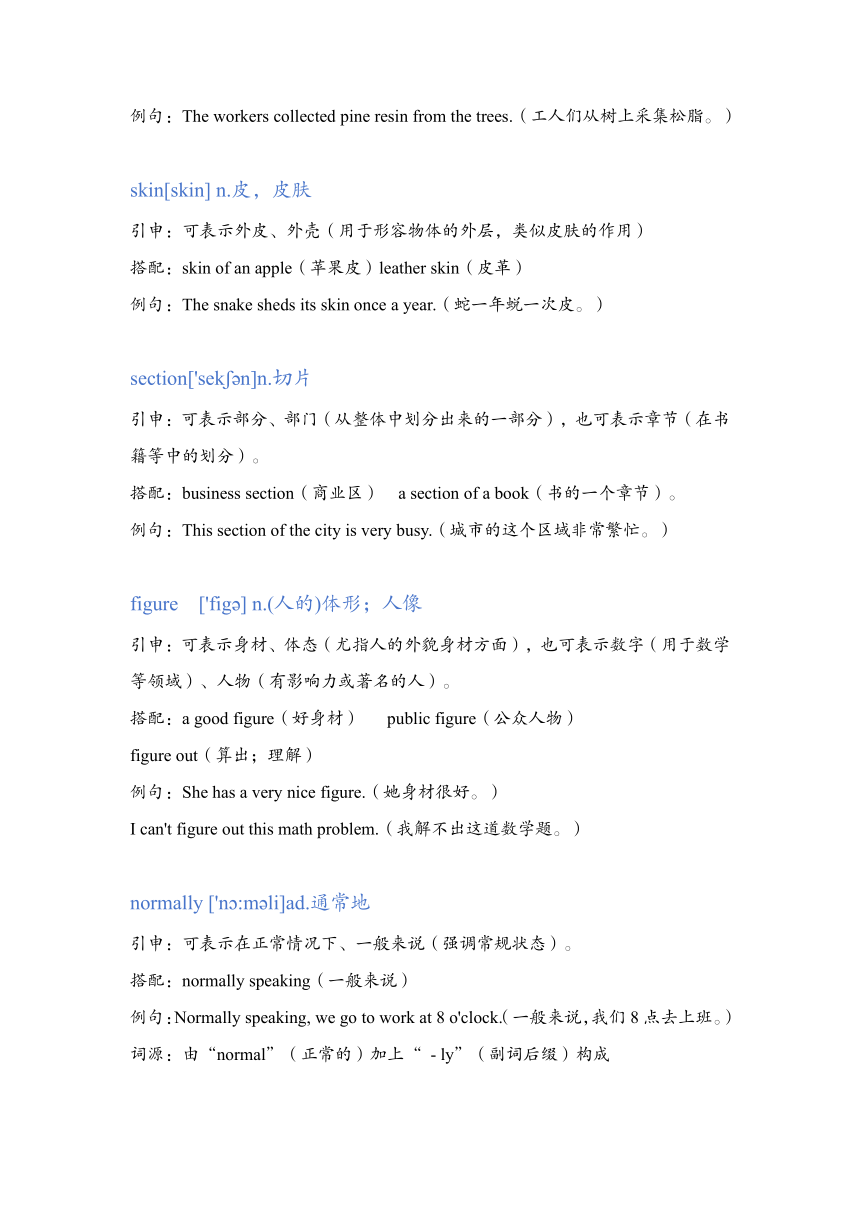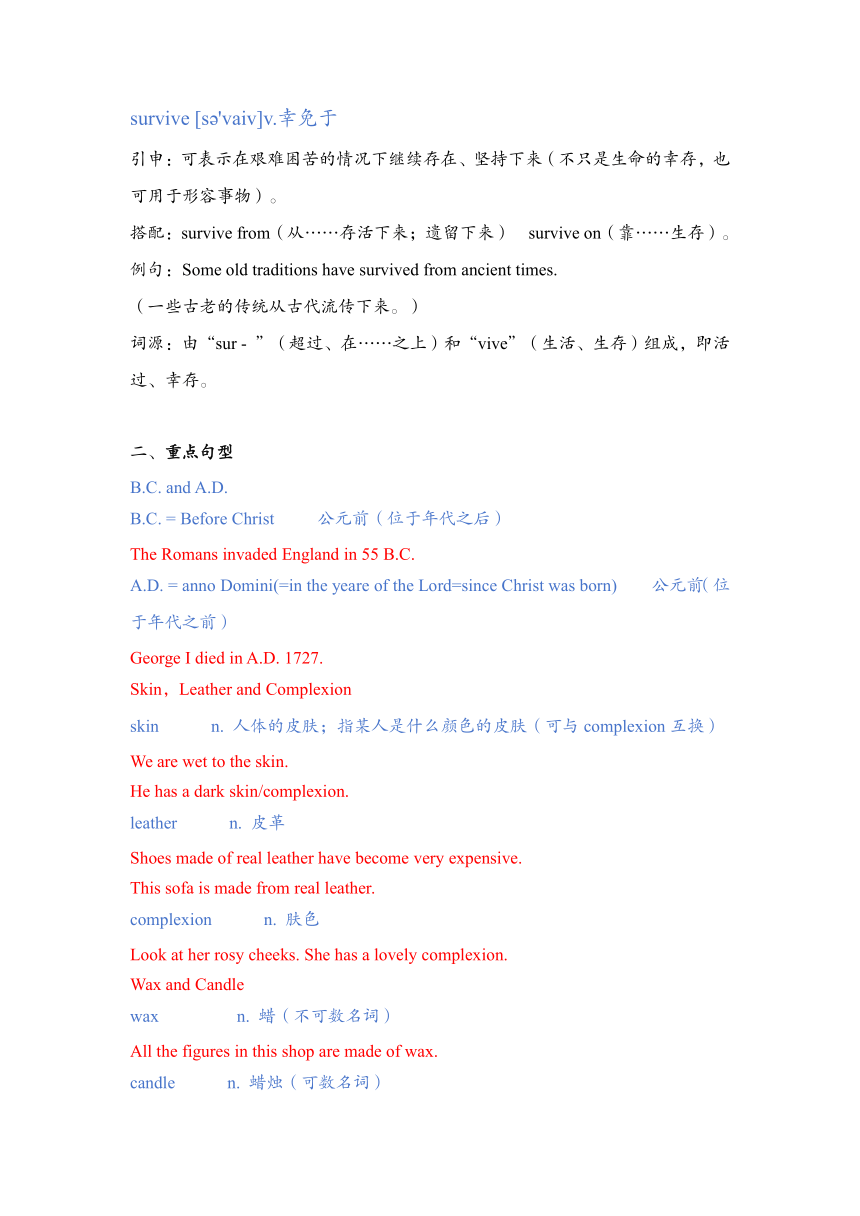新概念第二册Lesson 77 A successful operation讲义
文档属性
| 名称 | 新概念第二册Lesson 77 A successful operation讲义 |  | |
| 格式 | docx | ||
| 文件大小 | 125.0KB | ||
| 资源类型 | 教案 | ||
| 版本资源 | 新概念英语 | ||
| 科目 | 英语 | ||
| 更新时间 | 2024-11-24 21:47:20 | ||
图片预览




文档简介
新概念第二册
Lesson 77 A successful operation
单词精讲
mummy ['m mi]n.木乃伊
引申:象征古老、神秘的事物,也可指代类似木乃伊状态的干瘪物体。
搭配:mummy case(木乃伊盒)
例句:The archaeologists found a well - preserved mummy in the pyramid.(考古学家在金字塔里发现了一具保存完好的木乃伊。)
Egyptian [i'd ip n]a.埃及的
引申:可表示与埃及文化、习俗、历史等相关的事物。
搭配:Egyptian pyramid(埃及金字塔) Egyptian art(埃及艺术)。
例句:Egyptian art has a long and unique history.(埃及艺术有着悠久而独特的历史。)
词源:“Egypt”(埃及)加上表示“……的”后缀“ - ian”。
temple['temp l] n.庙
引申:可表示宗教或精神信仰的重要场所,也可引申为某种神圣或庄严的地方。
搭配:Buddhist temple(佛教寺庙) ancient temple(古老的庙宇)。
例句:Many people go to the temple to pray.(许多人去寺庙祈祷。)
mark [mɑ:k]n.斑点
引申:可表示标记、象征,也可表示成绩、分数等含义。
搭配:birth mark(胎记) make one's mark(留下印记;成名)。
例句:His speech made a deep mark on the audience.
(他的演讲给听众留下了深刻的印象。)
plate[pleit] n.(照相)底片
引申:可表示薄板、片状物,也可用于形容扁平的东西。
搭配:license plate(车牌) steel plate(钢板)。
例句:The photographer developed the plate carefully.(摄影师小心地冲洗底片。)
disease [di'zi:z] n.疾病
引申:可表示弊病、弊端(用于抽象概念,如社会弊病等)。
搭配:heart disease(心脏病) fight against disease(与疾病作斗争)。
例句:The government is trying to eliminate the social diseases.
(政府正在努力消除社会弊病。)
词源:由“dis - ”(表示否定、相反)和“ease”(舒适、安逸)组成,即不舒服,也就是疾病。
last [lɑ:st]v.持续
引申:可表示维持、足够(表示数量或程度上足以维持某种状态)。
搭配:last for(持续;维持)
例句:The water will last for three days.(这些水可以维持三天。)
prove[pru:v] v.显示出
引申:可表示证实为、原来是(表示结果证明是某种情况)。
搭配:prove to be(证明是;结果是)。
例句:His theory proved to be correct.(他的理论结果是正确的。)
词源:源自古法语“prover”,表示测试、证明。
resin['rezin] n.树脂
引申:可表示具有树脂特性的粘性物质,也可用于比喻某种粘性或凝固性的东西。
搭配:pine resin(松脂)
例句:The workers collected pine resin from the trees.(工人们从树上采集松脂。)
skin[skin] n.皮,皮肤
引申:可表示外皮、外壳(用于形容物体的外层,类似皮肤的作用)
搭配:skin of an apple(苹果皮)leather skin(皮革)
例句:The snake sheds its skin once a year.(蛇一年蜕一次皮。)
section['sek n]n.切片
引申:可表示部分、部门(从整体中划分出来的一部分),也可表示章节(在书籍等中的划分)。
搭配:business section(商业区) a section of a book(书的一个章节)。
例句:This section of the city is very busy.(城市的这个区域非常繁忙。)
figure ['fig ] n.(人的)体形;人像
引申:可表示身材、体态(尤指人的外貌身材方面),也可表示数字(用于数学等领域)、人物(有影响力或著名的人)。
搭配:a good figure(好身材) public figure(公众人物)
figure out(算出;理解)
例句:She has a very nice figure.(她身材很好。)
I can't figure out this math problem.(我解不出这道数学题。)
normally ['n :m li]ad.通常地
引申:可表示在正常情况下、一般来说(强调常规状态)。
搭配:normally speaking(一般来说)
例句:Normally speaking, we go to work at 8 o'clock.(一般来说,我们8点去上班。)
词源:由“normal”(正常的)加上“ - ly”(副词后缀)构成
survive [s 'vaiv]v.幸免于
引申:可表示在艰难困苦的情况下继续存在、坚持下来(不只是生命的幸存,也可用于形容事物)。
搭配:survive from(从……存活下来;遗留下来) survive on(靠……生存)。
例句:Some old traditions have survived from ancient times.
(一些古老的传统从古代流传下来。)
词源:由“sur - ”(超过、在……之上)和“vive”(生活、生存)组成,即活过、幸存。
重点句型
B.C. and A.D.
B.C. = Before Christ 公元前(位于年代之后)
The Romans invaded England in 55 B.C.
A.D. = anno Domini(=in the yeare of the Lord=since Christ was born) 公元前(位于年代之前)
George I died in A.D. 1727.
Skin,Leather and Complexion
skin n. 人体的皮肤;指某人是什么颜色的皮肤(可与complexion互换)
We are wet to the skin.
He has a dark skin/complexion.
leather n. 皮革
Shoes made of real leather have become very expensive.
This sofa is made from real leather.
complexion n. 肤色
Look at her rosy cheeks. She has a lovely complexion.
Wax and Candle
wax n. 蜡(不可数名词)
All the figures in this shop are made of wax.
candle n. 蜡烛(可数名词)
I keep a candle by my bed in case the lights go out suddenly.
课文精讲
The mummy of an Egyptian woman who died in 800 B.C. has just had an operation.
B.C. = Before Christ 公元前,放在年代的后面。
A.D. 公元,放在年代的前面,常常可以省略。
The mummy is that of Shepenmut who was once a singer in the Temple of Thebes.
that指代上文当中出现的名词the mummy。在指代特指事物时,尤其是在比较状语从句中,常用that和those指代提到的事物:
The cost of living here is lower than that in London.
that of和those of一般用于较正式的文体中:
It's colder than Guangzhou. × (北京、广州是地点,只有大小之分,本身没有冷和热)
The weather of Beijing is colder than Guangzhou. ×
The weather of Beijing is colder than the weather of Guangzhou.
= The weather of Beijing is colder than that of Guangzhou. ∨
The texts of Book Two are more difficult than those of Book One.
The area of the USA is larger than that of Britain.
Temple of Thebes 底比斯神庙
As there were strange marks on the X-ray plates taken of the mummy, doctors have been trying to find out whether the woman died of a rare disease.
take plates of sth. 给……拍片子
take photos of the mountain
take plate 拍片子,take photo 拍照片
“X - ray plates”指X光片,用于医学检查。
“rare disease”表示罕见疾病。
find out + 从句
die 是瞬间动词,不能和段时间连用。要和段时间连用,就必须变成系表结构be dead。die不能用be doing形式。若用了be doing,表示即将发生的动作。
He has died for three years. ×
die in the accident 死于车祸
die of + 内因 死于……
die of hunger
die of grief 死于悲哀
die from + 外因 死于……
die from wound (枪伤)
He died from the heart disease.
在日常生活表达当中,die of和die from可以互换。
The only way to do this was to operate.
way + of 做……的方式(做定语)
way + to do 做……的方式(做定语)
The only way to do this was to operate.
句子结构:主语是“The only way to do this”,其中“to do this”是不定式短语作后置定语修饰“way”;谓语是“was”,表语是“to operate”,这里的“to operate”是不定式作表语,表示具体的动作。
词汇精讲:
“operate”在这里表示做手术的意思。
The operation, which lasted for over four hours, proved to be very difficult because of the hard resin which covered the skin.
句子结构:这是一个主从复合句。主语是“The operation”,“which lasted for over four hours”是定语从句,修饰“operation”;谓语是“proved”,“to be very difficult”是不定式短语作表语,“because of the hard resin which covered the skin”是原因状语,其中“which covered the skin”是定语从句,修饰“resin”。
词汇精讲:“last”在这里表示持续,描述手术持续的时间。
“resin”指树脂,这里是木乃伊皮肤上覆盖的物质。
The doctors removed a section of the mummy and sent it to a laboratory.
句子结构:这是一个并列句。主语是“The doctors”,“removed a section of the mummy”是第一个分句,其中“removed”是谓语,“a section of the mummy”是宾语;“sent it to a laboratory”是第二个分句,其中“sent”是谓语,“it”指代前面的“a section of the mummy”,“to a laboratory”是地点状语。
词汇精讲:“remove”表示移除、取出,“section”表示部分,这里指从木乃伊上取下一部分。
“laboratory”表示实验室,是进行科学研究和检测的地方。
They also found something which the X - ray plates did not show: a small wax figure of the god Duamutef.
句子结构:这是一个主从复合句。主语是“They”,谓语是“found”,“something which the X - ray plates did not show”是宾语部分,其中“which the X - ray plates did not show”是定语从句,修饰“something”,“a small wax figure of the god Duamutef”是对“something”的补充说明。
词汇精讲:“wax figure”表示蜡像,这里是在木乃伊体内发现的物品。
This god which has the head of a cow was normally placed inside a mummy.
句子结构:这是一个主从复合句。主语是“This god”,“which has the head of a cow”是定语从句,修饰“god”;谓语是“was placed”,这是一般过去时的被动语态,表示被放置,“inside a mummy”是地点状语。
词汇精讲:
被动语态强调动作的承受者,这里说明这个神的雕像被放置在木乃伊内部。
The doctors have not yet decided how the woman died.
what 对名词提问,how对副词或介词短语提问。
how在这里是对of sth.提问的。要想用what提问,died后面加of。
decide v. 做出最终的判断,对……下判决,解决(悬案)
The police cannot decide yet which of the two men is guilty.
They feared that the mummy would fall to pieces when they cut it open, but fortunately this has not happened.
fear v. 害怕(长时间的)
cut open 切开
fall to pieces =go to pieces 碎成碎片,散掉
During the storm, the old house fell to pieces.
After two years their marriage fell to pieces.
The mummy successfully survived the operation.
句子结构:主语是“The mummy”,谓语是“survived”,“the operation”是宾语,“successfully”是副词,修饰“survived”。
词汇精讲:“survive”在这里表示在手术之后仍然保存完好,没有被破坏。
Lesson 77 A successful operation
单词精讲
mummy ['m mi]n.木乃伊
引申:象征古老、神秘的事物,也可指代类似木乃伊状态的干瘪物体。
搭配:mummy case(木乃伊盒)
例句:The archaeologists found a well - preserved mummy in the pyramid.(考古学家在金字塔里发现了一具保存完好的木乃伊。)
Egyptian [i'd ip n]a.埃及的
引申:可表示与埃及文化、习俗、历史等相关的事物。
搭配:Egyptian pyramid(埃及金字塔) Egyptian art(埃及艺术)。
例句:Egyptian art has a long and unique history.(埃及艺术有着悠久而独特的历史。)
词源:“Egypt”(埃及)加上表示“……的”后缀“ - ian”。
temple['temp l] n.庙
引申:可表示宗教或精神信仰的重要场所,也可引申为某种神圣或庄严的地方。
搭配:Buddhist temple(佛教寺庙) ancient temple(古老的庙宇)。
例句:Many people go to the temple to pray.(许多人去寺庙祈祷。)
mark [mɑ:k]n.斑点
引申:可表示标记、象征,也可表示成绩、分数等含义。
搭配:birth mark(胎记) make one's mark(留下印记;成名)。
例句:His speech made a deep mark on the audience.
(他的演讲给听众留下了深刻的印象。)
plate[pleit] n.(照相)底片
引申:可表示薄板、片状物,也可用于形容扁平的东西。
搭配:license plate(车牌) steel plate(钢板)。
例句:The photographer developed the plate carefully.(摄影师小心地冲洗底片。)
disease [di'zi:z] n.疾病
引申:可表示弊病、弊端(用于抽象概念,如社会弊病等)。
搭配:heart disease(心脏病) fight against disease(与疾病作斗争)。
例句:The government is trying to eliminate the social diseases.
(政府正在努力消除社会弊病。)
词源:由“dis - ”(表示否定、相反)和“ease”(舒适、安逸)组成,即不舒服,也就是疾病。
last [lɑ:st]v.持续
引申:可表示维持、足够(表示数量或程度上足以维持某种状态)。
搭配:last for(持续;维持)
例句:The water will last for three days.(这些水可以维持三天。)
prove[pru:v] v.显示出
引申:可表示证实为、原来是(表示结果证明是某种情况)。
搭配:prove to be(证明是;结果是)。
例句:His theory proved to be correct.(他的理论结果是正确的。)
词源:源自古法语“prover”,表示测试、证明。
resin['rezin] n.树脂
引申:可表示具有树脂特性的粘性物质,也可用于比喻某种粘性或凝固性的东西。
搭配:pine resin(松脂)
例句:The workers collected pine resin from the trees.(工人们从树上采集松脂。)
skin[skin] n.皮,皮肤
引申:可表示外皮、外壳(用于形容物体的外层,类似皮肤的作用)
搭配:skin of an apple(苹果皮)leather skin(皮革)
例句:The snake sheds its skin once a year.(蛇一年蜕一次皮。)
section['sek n]n.切片
引申:可表示部分、部门(从整体中划分出来的一部分),也可表示章节(在书籍等中的划分)。
搭配:business section(商业区) a section of a book(书的一个章节)。
例句:This section of the city is very busy.(城市的这个区域非常繁忙。)
figure ['fig ] n.(人的)体形;人像
引申:可表示身材、体态(尤指人的外貌身材方面),也可表示数字(用于数学等领域)、人物(有影响力或著名的人)。
搭配:a good figure(好身材) public figure(公众人物)
figure out(算出;理解)
例句:She has a very nice figure.(她身材很好。)
I can't figure out this math problem.(我解不出这道数学题。)
normally ['n :m li]ad.通常地
引申:可表示在正常情况下、一般来说(强调常规状态)。
搭配:normally speaking(一般来说)
例句:Normally speaking, we go to work at 8 o'clock.(一般来说,我们8点去上班。)
词源:由“normal”(正常的)加上“ - ly”(副词后缀)构成
survive [s 'vaiv]v.幸免于
引申:可表示在艰难困苦的情况下继续存在、坚持下来(不只是生命的幸存,也可用于形容事物)。
搭配:survive from(从……存活下来;遗留下来) survive on(靠……生存)。
例句:Some old traditions have survived from ancient times.
(一些古老的传统从古代流传下来。)
词源:由“sur - ”(超过、在……之上)和“vive”(生活、生存)组成,即活过、幸存。
重点句型
B.C. and A.D.
B.C. = Before Christ 公元前(位于年代之后)
The Romans invaded England in 55 B.C.
A.D. = anno Domini(=in the yeare of the Lord=since Christ was born) 公元前(位于年代之前)
George I died in A.D. 1727.
Skin,Leather and Complexion
skin n. 人体的皮肤;指某人是什么颜色的皮肤(可与complexion互换)
We are wet to the skin.
He has a dark skin/complexion.
leather n. 皮革
Shoes made of real leather have become very expensive.
This sofa is made from real leather.
complexion n. 肤色
Look at her rosy cheeks. She has a lovely complexion.
Wax and Candle
wax n. 蜡(不可数名词)
All the figures in this shop are made of wax.
candle n. 蜡烛(可数名词)
I keep a candle by my bed in case the lights go out suddenly.
课文精讲
The mummy of an Egyptian woman who died in 800 B.C. has just had an operation.
B.C. = Before Christ 公元前,放在年代的后面。
A.D. 公元,放在年代的前面,常常可以省略。
The mummy is that of Shepenmut who was once a singer in the Temple of Thebes.
that指代上文当中出现的名词the mummy。在指代特指事物时,尤其是在比较状语从句中,常用that和those指代提到的事物:
The cost of living here is lower than that in London.
that of和those of一般用于较正式的文体中:
It's colder than Guangzhou. × (北京、广州是地点,只有大小之分,本身没有冷和热)
The weather of Beijing is colder than Guangzhou. ×
The weather of Beijing is colder than the weather of Guangzhou.
= The weather of Beijing is colder than that of Guangzhou. ∨
The texts of Book Two are more difficult than those of Book One.
The area of the USA is larger than that of Britain.
Temple of Thebes 底比斯神庙
As there were strange marks on the X-ray plates taken of the mummy, doctors have been trying to find out whether the woman died of a rare disease.
take plates of sth. 给……拍片子
take photos of the mountain
take plate 拍片子,take photo 拍照片
“X - ray plates”指X光片,用于医学检查。
“rare disease”表示罕见疾病。
find out + 从句
die 是瞬间动词,不能和段时间连用。要和段时间连用,就必须变成系表结构be dead。die不能用be doing形式。若用了be doing,表示即将发生的动作。
He has died for three years. ×
die in the accident 死于车祸
die of + 内因 死于……
die of hunger
die of grief 死于悲哀
die from + 外因 死于……
die from wound (枪伤)
He died from the heart disease.
在日常生活表达当中,die of和die from可以互换。
The only way to do this was to operate.
way + of 做……的方式(做定语)
way + to do 做……的方式(做定语)
The only way to do this was to operate.
句子结构:主语是“The only way to do this”,其中“to do this”是不定式短语作后置定语修饰“way”;谓语是“was”,表语是“to operate”,这里的“to operate”是不定式作表语,表示具体的动作。
词汇精讲:
“operate”在这里表示做手术的意思。
The operation, which lasted for over four hours, proved to be very difficult because of the hard resin which covered the skin.
句子结构:这是一个主从复合句。主语是“The operation”,“which lasted for over four hours”是定语从句,修饰“operation”;谓语是“proved”,“to be very difficult”是不定式短语作表语,“because of the hard resin which covered the skin”是原因状语,其中“which covered the skin”是定语从句,修饰“resin”。
词汇精讲:“last”在这里表示持续,描述手术持续的时间。
“resin”指树脂,这里是木乃伊皮肤上覆盖的物质。
The doctors removed a section of the mummy and sent it to a laboratory.
句子结构:这是一个并列句。主语是“The doctors”,“removed a section of the mummy”是第一个分句,其中“removed”是谓语,“a section of the mummy”是宾语;“sent it to a laboratory”是第二个分句,其中“sent”是谓语,“it”指代前面的“a section of the mummy”,“to a laboratory”是地点状语。
词汇精讲:“remove”表示移除、取出,“section”表示部分,这里指从木乃伊上取下一部分。
“laboratory”表示实验室,是进行科学研究和检测的地方。
They also found something which the X - ray plates did not show: a small wax figure of the god Duamutef.
句子结构:这是一个主从复合句。主语是“They”,谓语是“found”,“something which the X - ray plates did not show”是宾语部分,其中“which the X - ray plates did not show”是定语从句,修饰“something”,“a small wax figure of the god Duamutef”是对“something”的补充说明。
词汇精讲:“wax figure”表示蜡像,这里是在木乃伊体内发现的物品。
This god which has the head of a cow was normally placed inside a mummy.
句子结构:这是一个主从复合句。主语是“This god”,“which has the head of a cow”是定语从句,修饰“god”;谓语是“was placed”,这是一般过去时的被动语态,表示被放置,“inside a mummy”是地点状语。
词汇精讲:
被动语态强调动作的承受者,这里说明这个神的雕像被放置在木乃伊内部。
The doctors have not yet decided how the woman died.
what 对名词提问,how对副词或介词短语提问。
how在这里是对of sth.提问的。要想用what提问,died后面加of。
decide v. 做出最终的判断,对……下判决,解决(悬案)
The police cannot decide yet which of the two men is guilty.
They feared that the mummy would fall to pieces when they cut it open, but fortunately this has not happened.
fear v. 害怕(长时间的)
cut open 切开
fall to pieces =go to pieces 碎成碎片,散掉
During the storm, the old house fell to pieces.
After two years their marriage fell to pieces.
The mummy successfully survived the operation.
句子结构:主语是“The mummy”,谓语是“survived”,“the operation”是宾语,“successfully”是副词,修饰“survived”。
词汇精讲:“survive”在这里表示在手术之后仍然保存完好,没有被破坏。
同课章节目录
